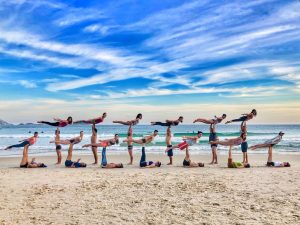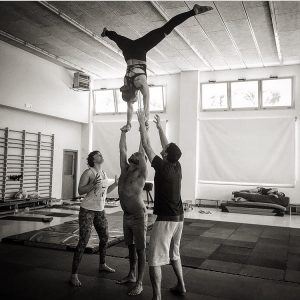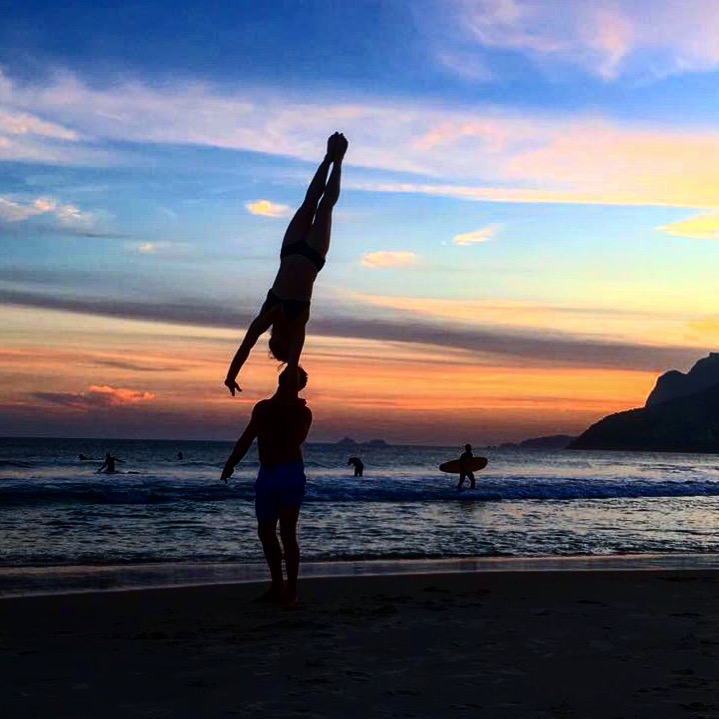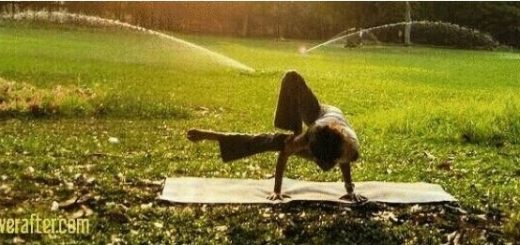Yoga for Presence & Connection: An Interview with Jason Nemer, co-founder of AcroYoga
Mid-July this year I began my 6-week Spain trip, my first stop being the Barcelona Yoga Conference as one of its official bloggers. A week full of various interpretations of Yoga, great live music, eating my weight in vegan gelato, Yoga enthusiasts from all over, and even getting two therapeutic flying sessions from the co-founder of AcroYoga Jason Nemer. One of which went like this:
One of Yoga’s best lessons: Gravity is negotiable
Before BYC 2018, the last time I tried AcroYoga was in 2015 with some friends in Bangalore’s Cubbon Park, but my fears got the better of me after a few days of facing them. So when Jason offered this therapeutic flying session, I had no idea if I’d be able to trust and relax into the experience or would I be my often-paranoid self? Turns out I can somehow trust & relax while being tossed up in the air 🤗 Travel is another word for trust if you ask me, so AcroYoga while travelling seems an apt extension to that. Here’s to more trust & experimenting with limits!
So often I’ve heard dismissal of and disdain toward the ‘tougher’ poses as being ‘just physical’ and ‘not Yoga’. AcroYoga especially is often dismissed as being ‘just acrobatics’. As if acrobatics is something to look down on and doesn’t require presence and connection – two essentials of Yoga practice. I had the chance to interview Jason about this and so much more in AcroYoga and Yoga in general. Articulate, funny and insightful, he made for a wonderful interviewee. Hope you enjoy reading, and let me know in the comments what you think 🙂

There’s a lot of opinion in the Yoga world today about the more difficult Yoga poses being a reduction of Yoga to gymnastics or acrobatics. But as you were saying in the class, there’s an emotional component to these poses as well. Can you tell us about that?
JN: There are many different ways to qualify what is difficult. Do you need more flexibility, strength, better alignment, do you need to trust yourself more? The more obstacles there are in front of you, the more the pose has to teach you.
Gymnastics is a solo sport and acrobatics is a partner sport. There are many ways to define acrobatics, the way that I define it is partner acrobatics. A lot of people who look at acrobatics and say that is not Yoga, I ask them – what is the definition of Yoga? When you watch two people doing acrobatics together, there’s definitely the potential that they’re doing some deep Yoga practice where they’re connecting to themselves and also connecting to another. As far as gymnastics goes, Krishnamacharya was very influenced by gymnastics and things like Chaturanga, jumping through to a seated pike, those were all things that he saw from the British gymnasts. So for better or for worse, the British influenced India a lot, even down to a harmonium or modern gymnastics being something that’s evolved the way that Yogis for thousands of years did Yoga. So it’s part of the lineage of Yoga that gymnastics did influence it at one point, and it continues to influence it.

So it’s ironic when people try to minimize someone’s Yoga by saying it’s just ‘gymnastics’ or ‘acrobatics’ because those things have a massive value in themselves so it’s not something to condescend on?
JN: Yes and you can do anything with Yogic awareness and you can do ‘Yoga’ with no Yogic awareness.
Right, that’s true. Like if you make your bed with full awareness that’s a moving meditation.
JN: A lot of times people specifically will say AcroYoga is not Yoga, I ask them have they ever tried it? That’s a good first question. What it looks like and what it feels like is different. And trying to describe states of being is like trying to describe what a mango tastes like to someone who has never tried it. You have to feel it to be able to describe it. So when people are trying to describe what it isn’t, but they’ve never experienced it, it doesn’t really have a lot of wisdom.
And they’re describing it on the basis of what they see, which is only the most overt aspect of it, just the top layer.
JN: Exactly.

The other thing that I found interesting in what you said was handstand as sensitivity training. So does that necessarily spill over into the rest of someone’s life or maybe not? I could get my perfect handstand and still be a total jerk.
JN: To do a handstand well, you have to understand the different aspects of your being. Whether it’s all the different joints of your body, muscles of your body, all the different aspects of who you are. You understand that you’re afraid of handstand. You understand that your ambition for handstand is ‘I want to be the coolest looking Yogi in the room’. Everyone’s got different emotional aspects as to why they want to do this. So the sensitivity of becoming more masterful in handstands is knowing your physical body well, knowing what your motivation is, being able to connect your intentions to your physical actions. So one of my teachers Dharma Mittra, his reason for doing inversions is a spiritual practice. He connects to god when he’s upside down. So one time he was going to show me this really cool forearm stand variation so he put his hands on the ground. He stopped, he stood up, his hands at his third eye and he just prayed for a moment and then put his hands down. It was a really beautiful moment to see that he does handstands for spiritual development. So there’s many different reasons why you do a handstand. So becoming more advanced at a handstand means you understand your ‘why’ and you understand how to open up the portals of your being to become more aligned with that ‘why’.
And that ‘why’ could be different for each person.
JN: It is.
It could be about the look factor, or facing your fears, or the adrenaline.
JN: For me at this point it’s for fun. For presence and for fun. I don’t train them anymore, I don’t really want to get better at them. I just enjoy it. As you saw today I did one handstand because someone asked about a bailout. So I’ll use it in a teaching environment but I don’t need to physically embody a handstand to teach it, because I understand the different aspects that I want to lead people through.
If you could teach one Yoga technique to everyone in the world, what would it be?
JN: I’d say my first response is meditation and or presence. And actually I thought of this before the class and I didn’t end up teaching it. A seated meditation and a handstand have a lot of similar end results, but they’re completely different when you’re in a practice. So the end result of a good meditation for me is centredness, clarity, stillness, calmness. And in a handstand as well, once you get past the fear, past a lot of layers, there’s a level of presence, a level of centre and peace. They’re the most extreme ends of the yoga practice where it’s fully engaged, potentially dangerous, very complicated. Anybody can sit, but when you’re seated in meditation, you don’t have to be present. But in a handstand, you have to be present. So I think meditation and presence, those states of being are super valuable to me. Acro yogis do have, on average, more presence because they’re balancing each other. They can’t be thinking about their boyfriend or girlfriend or their taxes. They’re a lot more present. And when I see that people are more present, there’s so much more they get out of their Yoga practice.

So they’re more present you mean in general life, or while they’re practicing?
JN: While they’re practicing, and the practice is a microcosm of your life. So whatever type of practice you’re doing. Let’s take contortion. It’s a style of acrobatics. A lot of people end up liking that practice because they don’t like themselves and they want to punish themselves, hurt their bodies and go to dark places.
Sounds like masochism.
JN: Exactly. The type of practice that you do ends up spilling over into your life. If I’m doing a present, joyful, connective practice with somebody 3 times a week in my Acro Yoga practice, chances are, outside of that practice I’m going to have more joy and connection.
That makes sense because you’re reinforcing those circuits in your brain so it would add up over a period of time. It has to have an effect somewhere.
JN: It’s homeopathic doses of these little moments of connection.
Interesting. The other question I had was about the value of alignment in an Asana. You were talking about how the bones do the work, so your muscles can relax. I’ve had this question as a teacher – how much do I emphasize on alignment? I don’t want to be a perfectionist about alignment where people forget to relax, they’re too scared and now it’s an exam. Because I’ve been with teachers like that and it’s not the direction I would want to go in as a teacher or a student.
JN: Right. Iyengar is a whole school of Yoga to teach you how many ways you can get a pose wrong.
And how many ways you can get whacked for doing it wrong.
JN: Exactly.
I was in a class like that about 4 years ago, where these teachers had been students of Mr BKS Iyengar for decades. There was a whole nervous atmosphere going on in the classes. Even if I get the perfect warrior, I don’t feel like I got my Yoga that day coz I was stressed.
JN: Well you got a different kind of Yoga. A stress-management performance Yoga.
Something like that, yes.
JN: Which isn’t something you want all the time, but some people might need that to balance who they are. I may need that medicine, but you probably don’t.
Yes! So coming back to the question, as a teacher I’m trying to walk that line between not being obsessed/perfectionist with the alignment and not being too relaxed with it either. So how would you suggest a teacher walks the right midline between the two?
JN: So there are many different philosophies of how to do Yoga and how to do acrobatics. I would imagine that most people would agree the better your alignment is, the more efficient you are and the less work. The more ease you’re having in your poses. I can do a Yoga practice next to a beginner and not be sweating and they can’t breathe and they’re pouring in sweat because they haven’t figured out the easy way to do it. So one way that i can help define what alignment is: how do you make the pose easy? And there are some poses, that by design, like Utkatasana, where you cannot find a way around the fact that you’re going to use a lot of muscle in that pose. But in Shadow Yoga which is something that I’ve been doing for about 6 years now, one of their philosophies is you put the Drishti into the bones, you let the bones take the weight, and you let the muscles relax so you can circulate Prana. So this is a very different way to do Yoga than a lot of other people and even in acrobatics we do a lot of muscular activation. So this is why the Shadow Yoga practice helps balance my body because i’m not using my muscles in my Yoga practice. I’m using my bones. In acrobatics I’m using my muscles and my bones. So until you really define what you want to shift about your body or where you want your practice to evolve, you can’t figure out what your right alignment is. And alignment is also through the different parts of the body and it’s your mind, your heart, it’s your passions, your fears.There’s a lot of ways to look at alignment. Let’s take the Iyengar Yogis. They’re very cerebral and very strict on average. Take a Kundalini yogi, when you’re doing your Kundalini exercises they’re trying to unlock more emotional aspects. So alignment for my teacher Dharma Mittra is finding a way to connect to God. That’s his main alignment cue. When you’re talking about proper alignment, there is physics and physics works the same on acrobats and Yogis. There’s biochemistry unlocking pineal gland, unlocking chemicals in the body, and then there’s being able to align your life, wisdom, and your direction with the actions that you’re doing in your Yoga practice. So alignment is a very big topic.
So it’s not something you need to squeeze into the box of ‘physical’?
JN: So the founder of Shadow Yoga, Hungarian martial artist Zhander Remete studied with Iyengar for a long time so there are some traditional Hatha Yoga alignment cues but really it’s about relaxing the muscles, finding the centre of your foot. Because when you find the centre of your foot, you’re not gripping your hamstring or your quads. When you’re forward in your foot, your hamstrings are fired. When you’re more on your heel, your quads are fired. That’s what keeps you on your centre. So when you find the centre of your foot, the muscles can relax and then you do bandha work. What that does is, your mind doesn’t tell your L3 where to go, but if you do the bandha it puts the alignment from the inside of your body out. So it’s not like you’re thinking about I’m putting my knee over my ankle, this is a 90 degree angle. That’s very mental. Whereas Shadow Yoga alignment is a lot more feeling and a lot less thinking.
Okay, so you’re saying that’s a feature of Shadow Yoga, but isn’t that the general point of alignment that the bones are stacked on each other a certain way so the muscles can relax and your nervous system is a lot more relaxed?
JN: In Boat pose, a lot of Power yogis would have all the muscles engaged. They’re using that to burn calories to make the belly smaller. So again, each pose, until you define where you want to go, you don’t know what physical alignment and what tissues you’re going to be activating. Are you doing this pose for your liver or your heart or to get more oxygen in your body or to connect to God? You’re alignment will be different based on your goal.
When you started with AcroYoga what drew you to it?
JN: So I met the co-founder Jenny and she had some of the therapeutic flying experience and Thai massage. And I had a lot of the acrobatic experience. We were both Yoga teachers and the first night we met we were up until 5 a.m. talking about this practice that became AcroYoga. Just completely happened from the meeting. Both of our life stories combined and boom! AcroYoga was there. Couldn’t stop it, and it was a really interesting and beautiful moment.
And it’s great the way it has caught on everywhere. In Bangalore I see people in parks on Sundays doing AcroYoga jams.
JN: The first time I had people from India and Thailand get certfied in AcroYoga it was such an honour to have these people from these countries where a lot of the wisdom of AcroYoga was generated. Now it’s giving back. First time I taught Yoga in India, TimeOut magazine did an article about it. And they said, ‘Looking at the AcroYoga website, people look really happy when they do AcroYoga. What do you think the Indian Yogis will think about this?’ I said I think they’ll like it and have fun! Many Americans don’t know that in India the image of Yoga is ‘that’s what my grandfather or uncle did’, it’s not a fun practice, but a very strict one. And the first Indian woman who was certified in AcroYoga had some beautiful things to say about how she saw AcroYoga helping men and women find a healthy way they can touch each other, because there’s a lot of rape, suppression of touching and communication. So she was really excited to be able to bring this practice to India, to be able to give people a way to interact safely.
That’s great how it fits into the culture and adds a whole new dimension to men and women interacting with each other. Is there anything else you’d like to mention to the readers of the blog?
JN: Whether it’s the Catalan people or the people of Madrid or Palestinians, men or women, the nature of humanity is such that there will be separation, struggle, and wounds. I love that Yoga is a practice that helps us evolve, it helps us digest the wounds of life. There’s no way to live as a human and not get wounded. Having a community of people around the world that are dedicated to supporting each other, helping heal and helping find common ground. I’ve seen it around the world. I’ve seen a Palestinian at an immersion in Israel. There was a lot of emotion and misinformation and there was a lot of healing that happened in that experience. So I know there’s going to be a lot more struggle in my life as I wander the world and watch different people or “types” of people. At the end of the day, all I’ve seen as I’ve travelled all over the world for the past 8 years, there are a lot more similarities in what humans desire and appreciate than there are differences be it language, culture, age. We want to be loved, supported, challenged, embraced by people, spoken to in an honest respectful way. So many commonalities. There’s a lot of fear and stupidity that keeps us feeling very separate. The goal of Yoga is connection. This is a practice that has helped a lot of people get past their obstacles to connecting.
What are the 3 most important qualities of a Yoga teacher? Especially given the context of so many teachers having used teaching as an instrument of power. So many episodes of abuse have been exposed.
JN: I’d say number one is authenticity. To be authentic you have to be in your own transformation, to know who you are, and that evolves everyday. So I would say be authentic and be in your practice. Know that your practice is going to change. So when I teach Yoga I really like to do my Yoga practice that morning before I teach it. I like my practice to be the well-spring of my teaching. Many people teach 20 classes a week, especially in places like New York, and they stop practicing. They start teaching from their mind versus from their well-spring of physical practice. So be authentic, be in your practice and be curious. Because if you think you know, you’re going to miss so much from what your students offer you. Be humble and curious and let your students be your teachers. A lot of the abuse that’s happening is from people not understanding who they are, a lot of suppression and extreme behaviour. We are humans, so by design we are attracted to other humans. In the Catholic church and many cultures that have a lot of segregation of the genders. When you don’t understand what your wants and needs are, and they’re suppressed, then there’s a lot of abuse of power and unbalanced behaviour. So get on your mat, figure out who you are. Make sure you’re a balanced, centred person when you get in a room. Share your struggles, share who you are.
Seems like the problem of abuse in the Yoga world has a lot to do with the culture of idealization, especially in India and even in the West in places like Sedona. What would you say about that, because that goes into a student’s responsibility, to not idealize a teacher no matter how wonderful they may seem?
JN: Have people around you who are true friends. Like me and Janet, we’ve been hanging out for over 15 years and we know so much about each other. Keep coming back to being with grounded people who will tell you the truth. I’ve also had a lot of really amazing teachers who show me about humility. I’ve seen some of the highest level acrobats, really amazing yogis. I’ve always known that there are people who have skills I don’t have. So being humble, appreciating what you have, but don’t let it get to your head. The difference is, if a student puts you up on a pedestal, it’s your opportunity to be authentic with them. And let them know that that pedestal is not where you live. I actually had a student one time, I went to their house, and my picture was on their altar. I told them I thought that was weird and I didn’t like it. People’s projections are their journey, if I’m authentic and I know who I am and I’m sharing who I am, it doesn’t really matter so much what other people’s vision of me is. The people who know me are going to help keep me centred while lots of other things lift me up.
So that’s on the teacher’s side, to be responsible and self-aware and all of that. But what about the general people who walk into a class and are blown away by this wonderful teacher who just filled a gap in their lives and it’s so easy to fall into idealizing a teacher. So what’s a student’s responsibility in that scenario?
JN: I don’t think it’s necessarily wrong or bad. I met Oprah Winfrey a couple months ago and I was star-struck. She’s so beautiful and amazing. At the same time, I keep myself in check because I’ve met a lot of these people and I’ve seen they have the same struggles. If you see enough different cultures, humanity is humanity. If and when you meet those famous fancy people, what they appreciate the most is if you treat them normal. That’s what they crave because when people get put on a pedestal, you cannot connect on a human level. And this is again something I love about the Acro practice – we’re bases, flyers and spotters. You can’t take your billion dollar bank account into Acro Yoga practice. You can’t take your Mercedes Benz, your Grammy-nominated album.
You’re going to land on your ass with your billion dollar bank account.
JN: Yes, you’re humans and you’re connecting on that human level. So that can help keep things in perspective when you get to switch the roles between the base, the flyer and the spotter.
You’re in touch with your humanity while doing that, throughout all of the falling, the getting up..
JN: Exactly.
This has been a really nice interview, thank you. To end with, do you have any trainings coming up? And if people want to reach you, how can they do that?
JN: Yes, there is a festival in Athens, on Facebook as Athens Acro Yoga Fest. The website is acroyoga.org. And my Instagram handle is my name @JasonNemer.
So there you have it! Hope you enjoyed this conversation. I would love to hear from you so feel free to share your thoughts, suggestions and questions in the comments below. Until next time 🙂





Thank you so much for sharing a great information. I appreciate your time and effort in your work. Keep posting.
The main purpose of yoga is to increase awareness and presence of mind. Keep up the good work and share more posts like this.